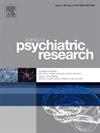Eyes on the body: Assessing attentional bias toward body-related stimuli in Anorexia Nervosa
IF 3.7
2区 医学
Q1 PSYCHIATRY
引用次数: 0
Abstract
Objective
The aim of the present study was to assess whether patients with Anorexia Nervosa (AN) presented an attentional bias toward pictures of other women's bodies, as this bias could implicitly promote self-other comparisons thus increasing body/weight concerns.
Methods
The sample included 48 healthy controls (HC) and 54 patients with AN. All participants performed a dot-probe task with pictures of bodies or body parts of underweight (UWB), normal weight (NWB) and overweight (OWB) women, while their gaze was recorded with an eye-tracking system. Two indices of attentional bias, a gaze direction bias and a gaze duration bias were extracted.
Results
The models conducted on both direction bias and duration bias showed a significant main effect of group, revealing a stronger attentional bias toward bodies in patients as compared to controls. One sample t-tests conducted on the direction bias of patients with AN revealed that they presented a significant positive bias at 500 ms toward all the bodies. At 1500 ms, instead, they presented a positive bias toward UWB and an avoidance bias of OWB. HC instead presented an initial avoidance of all body stimuli, and an avoidance of NWB and OWB at 1500 ms.
Discussion
Our results revealed a stronger attentional bias toward other women's bodies in patients than in HC. Moreover, patients presented a tendency to focalize their attention on UWB while they avoided maintaining their attention on OWB. This pattern might promote upward social comparisons, which are usually associated with negative self-evaluation and increased levels of body dissatisfaction.
求助全文
约1分钟内获得全文
求助全文
来源期刊

Journal of psychiatric research
医学-精神病学
CiteScore
7.30
自引率
2.10%
发文量
622
审稿时长
130 days
期刊介绍:
Founded in 1961 to report on the latest work in psychiatry and cognate disciplines, the Journal of Psychiatric Research is dedicated to innovative and timely studies of four important areas of research:
(1) clinical studies of all disciplines relating to psychiatric illness, as well as normal human behaviour, including biochemical, physiological, genetic, environmental, social, psychological and epidemiological factors;
(2) basic studies pertaining to psychiatry in such fields as neuropsychopharmacology, neuroendocrinology, electrophysiology, genetics, experimental psychology and epidemiology;
(3) the growing application of clinical laboratory techniques in psychiatry, including imagery and spectroscopy of the brain, molecular biology and computer sciences;
 求助内容:
求助内容: 应助结果提醒方式:
应助结果提醒方式:


